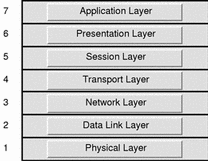Open Systems Interconnection (OSI) Reference Model
The OSI reference model is used to conceptualize network service architectures and as a convenient framework for explaining networking concepts. It is not the basis for the Internet protocol suite, but the Internet protocol's four-layer model can be mapped to the more general OSI reference model. The OSI protocol suite follows the OSI reference model closely.
The OSI reference model divides networking functions into seven layers, as shown in Figure 1-3. Each protocol layer performs services for the layer above it. The ISO definition of the protocol layers gives designers considerable freedom in implementation. For example, some applications skip the presentation and session layers (layers 5 and 6) to interface directly with the transport layer. In this case, the application performs any needed presentation and session services.
Industry standards have been or are being defined for each layer of the reference model.
Figure 1-3 OSI Reference Model

OSI Reference Model Description
The following section explains each layer the OSI reference model.
Layer 1: Physical Layer
This layer specifies the physical media connecting hosts and networks, and the procedures used to transfer data between machines using a specified media. This layer is commonly referred to as the hardware layer of the model.
Layer 2: Data-Link Layer
This layer manages the reliable delivery of data across the physical network. For example, it provides the abstraction of a reliable connection over the potentially unreliable physical layer.
Layer 3: Network Layer
This layer is responsible for routing machine-to machine communications. It determines the path a transmission must take, based upon the destination machine's address. This layer must also respond to network congestion problems.
Layer 4: Transport Layer
This layer provides end-to-end sequenced delivery of data. It is the lowest layer that provides applications and higher layers with end-to-end service. This layer hides the topology and characteristics of the underlying network from users. It provides reliable end-to-end data delivery if the service characteristics require it.
Layer 5: Session Layer
This layer manages sessions between cooperating applications.
Layer 6: Presentation Layer
This layer performs the translation between the data representation local to the computer and the processor-independent format that is sent across the network. It can also negotiate the transfer formats in some protocol suites. Typical examples include standard routines that compress text or convert graphic images into bit streams for transmission across a network.
Layer 7: Application Layer
This layer consists of the user-level programs and network services. Some examples are telnet, ftp, and tftp.
- © 2010, Oracle Corporation and/or its affiliates
